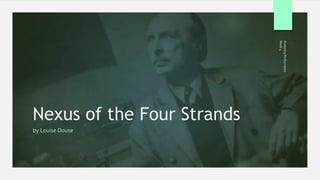
21.02.22 Analysing Performance - Nexus of the four strands
- 1. Nexus of the Four Strands by Louise Douse Week 4 Analysing Performance
- 2. Rudolf Laban Hungarian Dancer/Choreographer and MovementTheorist (1879-1958) Father of Choreology - 1962 “A kind of grammar and syntax of the language of movement dealing not only with the outer form of movement but also with its mental and emotional content.” Week 4 Analysing Performance
- 3. Valerie-Preston Dunlop Leading pioneer in choreological studies Key works: Dance and the Performative: a choreological perspective – Laban and beyond Week 4 Analysing Performance
- 4. “ ” Everything which humans produce is “significant” for themselves and each other, because humans in principle live “in a signifying world”…. Every sound, action, object, or custom… involves the production of meaning. FISCHER-LICHTE, 1992, P. 1 What are sign systems in performance? Identify some examples, you have 2 minutes... Week 4 Analysing Performance
- 5. Nexus of the four strands of the dance performance medium Performer Movement Sound Space Week 4 Analysing Performance
- 6. Description vs. Interpretation Description Preacher Upright posture, eyes and hands raised High jumps, precise, fast movements Nihilism Limited dramatic action Language is often dislocated, full of cliches, puns, repetitions Interpretation Preacher Pious Fire-and-brimstone Nihilism Meaningless Absurdist Week 4 Analysing Performance
- 7. Performer Number Sex Role Trained/untrained – ability Appearance – facial expression etc. Costuming realistic, abstract, characterised and their advantages and disadvantages. practical aspects, allowing and restricting movement, formal, flow, line, size, weight, colour, texture, decoration. Week 4 Analysing Performance
- 8. Movement Actions Dynamics Gestures Posture Touching behaviour Facial expressions Eye behaviour Proxemics Week 4 Analysing Performance
- 9. Movement Action Gestures, Jumps,Turns,Travels, WeightTransference, Stillness Dynamic Laban –Weight: Light, Heavy Flow: Free, Bound Space: Indirect, Direct Time: Sustained, Sudden Week 4 Analysing Performance
- 10. Movement Gestures Speech independent. These gestures are not tied to speech, but they have a direct verbal translation, usually consisting of a word or two or a phrase. For example: “A-ok” and “Peace”. Speech related.These gestures are directly tied to, or accompany, speech – often serving to illustrate what is being said verbally. For example, pointing to an object, emphasising a word or phrase. (Knapp, M. & Hall, J. 2006, pp. 8-9) Week 4 Analysing Performance
- 11. Movement Posture Attention or involvement Degree of status Degree of liking for the other person For example: a forward-leaning posture has been associated with higher involvement, more liking, and lower status. Emotional states – rigid/tense=angry, drooped=sadness Mirroring – reflect, or attempt to build rapport (Knapp, M. & Hall, J. 2006 Pg. 9) Week 4 Analysing Performance
- 12. Movement Touching Behaviour Self-focused Reflect a persons particular state or habit Biting nails when nervous, reaching for cigarette when anxious Other focussed Stroking, hitting, greetings and farewells, holding, guiding, etc. Irritate, condescend, comfort, etc. Depends on context, nature of relationship, and manner of execution (Knapp, M. & Hall, J. 2006 Pg. 9) Week 4 Analysing Performance
- 13. Movement Facial Expressions Emotional states: anger, sadness, surprise, happiness, fear and disgust. Regulatory gestures, providing feedback: A yawn could indicate “I’m bored” closing down channels of communication, and replacing speech Raising of eyebrows combined with a nod of the head could indicate an agreement. (Knapp, M. & Hall, J. 2006 Pp. 9-10, 296) Week 4 Analysing Performance
- 14. Movement Eye Behaviour Gaze Regulating the flow of communication Monitoring feedback Reflecting cognitive activity – thinking Expressing emotions Mutual gaze (Knapp, M. & Hall, J. 2006 Pg. 10) Week 4 Analysing Performance
- 15. Movement Proxemics Territory zones: Intimate: 6 - 18 inches Personal: 1 1/2 - 4 foot Social: 4 – 12 foot Public: over 12 foot Orientation/Arrangement – status, co-operation, competition, conversation Territorial behaviour (Argyle, M. 1988 Pp. 168-187) Week 4 Analysing Performance
- 16. Sound Silence Voice – accent, intonation, timbre, volume Words Spoken poetry or prose Sound (natural and found) Music in a range of styles. Features: e.g. tone, texture, timbre, accent, dynamics, style, structure, content, orchestration, rhythm. Week 4 Analysing Performance
- 17. Space Set Design, Lighting, Props,TechnicalVisual elements realistic, abstract, site-specific, backdrop/cyclorama and their advantages and disadvantages. Features: e.g. colour, material, texture, shape, size, levels, entrances and exits, decoration, placement. Week 4 Analysing Performance
- 18. The Nexus of the Four Strands Performer Movement Sound Space Week 4 Analysing Performance
